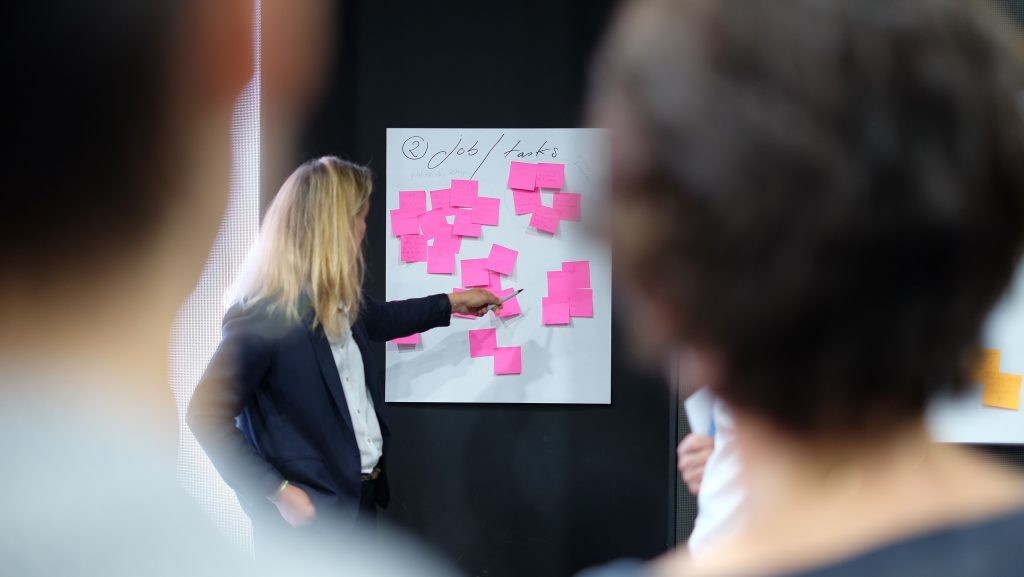
When comes to project management and innovation, agile methodology is leading the trends. We have already addressed the matter a few times in this blog, but now let’s address it from the beginning.
What is agile methodology after all? What are the assumptions behind such method? What types are used by us at Mercadoe to manage and optimize our projects?
Keep on reading!
What is agile methodology?
It’s a set of techniques and practices to accelerate value delivery in the development of products and projects. The idea behind this concept is to make processes simpler, faster and more flexible. In this way, besides being able to speed up deliveries, businesses can save time, money and a lot of effort.
When originally created, its goal was only to speed up software development. However, the idea was truly innovative and, currently, different methods dominate the technology market and revolutionize several business areas.
Among its key characteristics, we can highlight the following:
- Ongoing process improvement
- Cooperation between teams and customers
- Performance through delivery sprints and high quality
- Flexibility in project scope
- Adaptation and creation of value according to customer’s needs
Agile manifesto: assumptions behind the concept
The agile manifesto emerged in early 2001, when a group of renowned developers met in Utah (USA), to discuss ways of development, in order to optimize processes based on their design experiences.
At this meeting, those professionals signed a document titled “Manifesto for Agile Software Development”, which established some principles of agile methodology, in addition to 4 key fundamentals:
- People and interactions above processes and tools
- Software running on top of a comprehensive documentation
- Collaboration with customers above contract negotiations
- Prioritizing response to change, more than following a plan
What agile methodologies are used by Mercado Eletrônico in its processes?
Mercado Eletrônico has been using agile methodologies since 2015. In our processes, we use the Scrum framework and the Kanban method to deliver faster solutions, adapted to customers’ needs.
The deployment of both work methodologies has been conducted by the company’s own professionals. This choice was used as training for work based on employee engagement, and brought direct benefits to our company and customers.
Additionally, we use other practices that help us throughout the product and project life cycle. In the Discovery process, which occurs before any development can start, for instance, we adopted Design Thinking and Design Sprint.
Learn more about these methodologies:
Scrum
Scrum is a management framework intended to accelerate value delivery in the development of products and solutions.
The product or customer representative (the Product Owner) creates a priority list, usually known as backlog. Activities are thus distributed to the Scrum Team, which starts the sprints (development time windows).
At the end of each stage, reviews, activity adjustments and validations are made.
At ME, Scrum teams use Retrospective sessions to discuss improvements that can help them to have more integration and harmony, which contributes to team maturation.
We have a varied team, with expertise in back-end, front-end, testing, functional analysis and design, in addition to an important role created by us, called “Delivery Leader”. This function is performed by a senior professional from the technology area, whose goal is to support teams in estimating and doing development. This assignment has contributed to knowledge acquisition and sharing significantly.
Kanban
It’s an organizational method that intends to increase productivity and optimize the way tasks and deliveries are conducted.
Its versatility allows introducing it in an incremental and appropriate basis, in all kinds of organizations, without concern of over-commitment or culture shock. This makes Kanban easy to implement in any business model, as there is no need for major changes.
At ME, Kanban teams follow a phased model, with activities of demand analysis and comprehension that we call “UpStream” – that is, all activities from stages that precede development, to assure that user stories are ‘ready’ for the next cycle, which we call “DownStream”. This cycle contains all development activities, until the stories are implemented in the production environment.
Kanban teams hold also daily meetings, in order to monitor activities; they use the board too, making the workflow visible to the whole organization.
Design Thinking
It’s a useful design methodology for problem solving purposes, no matter if they are complex, poorly defined or even unknown.
Design Thinking looks for insights throughout the process. These insights can reveal new and untapped ways of looking at problems and creating solutions, as well as simple and effective deployment ways.
The customers are involved in several stages of a Design Thinking process, so Mercado Eletrônico’s teams can understand their needs and how our solutions can help them.
Design Sprint
It can quickly align teams through a shared vision, with clearly defined goals and deliverables. It’s a tool to develop a hypothesis, prototype an idea and then test it quickly, with the minimum investment possible, in an environment as real as possible.
This process is cyclical and offers businesses the chance to create something from scratch, in a short term. Reality is represented at this moment, even in a simplified way, to enable customer validations and tests before any deployment. The idea here is to achieve effective and error-free projects.
Want to know more about this subject? Not long ago, we posted a text about “4 agile methodologies that favor innovation in companies“. Don’t miss it!
Take this opportunity and subscribe to our newsletter, to stay updated on everything that happens in the B2B market.
See you next time!


 Português do Brasil
Português do Brasil Español
Español Português
Português
